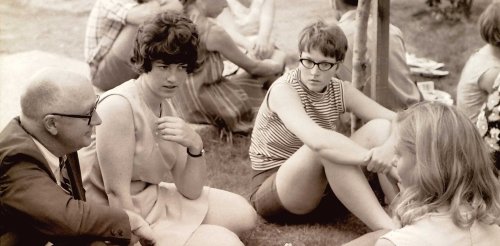“I Like the Prospect of People Rocking the Boat”
Pitzer College's founding president, John W. Atherton, reflects on the struggles of creating a truly participatory campus.

Editor’s note: In a 1993 interview, the College's founding president, John W. Atherton, reflected on his experiences as president during the creation of Pitzer's governance structure. These remarks have been adapted from those interview notes and cast in an essay format.
The mandate for the establishment of Pitzer within The Claremont Colleges was to create a new women's college with an emphasis on the social and behavioral sciences. It was the ’60s, the time of the Berkeley riots; students were beginning to demand greater involvement in their own education.
I loved Claremont Men’s (McKenna) College; I loved working there, and George Benson was a wonderful person to work with. But the structure of the college — as with the others in Claremont — was hierarchical. There was not much interaction among students, faculty, and the administration and the board.
I wanted to have all members of the community — trustees, faculty, staff, and students — involved on all committees, involved in making real decisions. As dean of the faculty at CMC, I tried to use as much faculty input as possible. Problems were much easier to resolve than when a decree is issued to a department from the dean.
In terms of its participatory approach to governance, Pitzer is most distinctive. At the time we began, the members of the American Association of Colleges were exploring ways of increasing the meaningful input of students. They never got very far. The colleges were too conservative, and the faculties weren’t too interested in sharing power with students.
A new president has the greatest leeway in shaping the new college through the selection of the first faculty. The original faculty was receptive, young, and open for participation. ... I hired instructors and assistant professors in the social sciences; they were ready for experiment, ready to try something new. The first faculty were young, feisty, excited; anxious to be part of a new college where they could come in and create their own courses and curriculum. In their turn they tended to recruit teachers like themselves.
I like activism. I like the prospect of people rocking the boat. There was always something going on on campus. For example, on the question of going co-ed, the faculty and students thought it was crazy for a college in the social sciences to admit women only. There was much excited discussion among all of us — faculty, students, trustees. We set up a special committee with everyone represented to consider the question. When we became co-ed in 1970, we were all in agreement. There was no trouble with the board. It took seven years and plenty of debate, but it worked.
In general, the participatory process demands a tremendous amount of time from everyone involved. Pitzer could never have survived if it hadn't been part of The Claremont Colleges. The other colleges were coming closer to the same model, but they didn't change their structures; they didn't really try to incorporate students, faculty, administration, and trustees into active committees. The reputation and conventional structure of the other colleges in Claremont enabled Pitzer to take the risk of being “experimental.”
For more on the impact of John and Virginia Atherton at Pitzer, read the special Participant issue from 2012 dedicated to their contributions.
Read the 2012 Issue